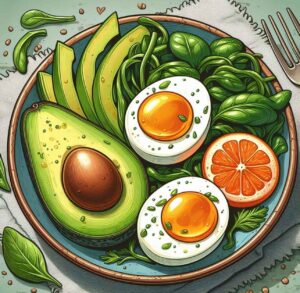Welcome Blessings!
(Tap 🔽 to see more topics!)


Are you tired of those energy dips and sudden sugar cravings that derail your day? The secret to feeling more balanced might lie in simple glucose hacks and specific strategies to help stabilize your blood sugar. We’ve all felt that infamous 3 pm slump. One minute, you’re crushing your to-do list. Next, you’re blankly staring at your screen, fantasizing about a nap or a muffin. Sound familiar?
Even if you do not have diabetes, your blood sugar levels play a huge role in your energy, mood, focus, and even those sneaky cravings that hit you out of nowhere. It’s not just a “diabetic issue” anymore. More and more research is showing that blood sugar spikes and crashes are quietly messing with everyone, from busy moms and students to fitness junkies and entrepreneurs.
So, let’s talk solutions. In this article, you will learn the ten science-backed, surprisingly simple hacks that can flatten those glucose spikes, keep your energy steady, and help you stop reaching for sugar at 4 pm like it’s your job.
Start Your Meal with Fiber (Not the Bread Basket)
Think of your stomach as a nightclub and glucose as that rowdy guest who loves to cause chaos when they get in first. But what if you had a bouncer at the door? That’s fiber. Eating fiber before carbs (like starting a meal with veggies) slows down the digestion and absorption of sugars, acting as a protective layer that calms the glucose response.
Why it works:
Fiber, especially from non-starchy vegetables, helps slow down gastric emptying and reduces the glycemic impact of what follows. This means fewer spikes, more stable energy, and less fat storage.
Try this:
Bonus tip: Use the 10-minute veggie starter rule. It’s simple, doable, and wildly effective.
Add Vinegar to Your Routine (Yes, Really!)
Apple cider vinegar isn’t just for Pinterest detox hacks. It’s backed by real science regarding blood sugar regulation.
How it helps:

Try this:
Heads up: If you have acid reflux or gut issues, go easy and test what works for your body. Lemon juice has a milder effect but can still help.
Move After You Eat (Even Just for 10 Minutes)
This one’s a game-changer. Think of your muscles like little glucose vacuums. After you eat, especially carb-heavy meals, your blood sugar rises, but if you move, your muscles start sucking that sugar out of your bloodstream to use as fuel.
Why it matters:
We’re all busy, but combining habits like walking while on a call or doing chores after dinner makes this doable. Post-dinner walks also help improve sleep. Win-win!
Swap Naked Carbs for Balanced Bites
Let’s talk about what I call “naked carbs.” That’s when you eat carbs alone, like grabbing a banana, a slice of toast, or even a handful of crackers. The problem? Your body digests these super fast, leading to a quick glucose spike and a crash.
The fix:
Always pair carbs with protein, fiber, or healthy fats. This slows digestion, gives you longer-lasting energy, and helps curb cravings.
Examples:
Think of it as giving your carbs clothes, protein, and fat, like jackets that keep your glucose from spiking wildly.
Get Morning Sunlight
This one might sound random, but circadian rhythm plays a significant role in insulin sensitivity.
Why it works:
Getting natural light early in the day helps regulate your body clock, improves cortisol balance, and supports better daily glucose metabolism.

Try this:
Stay Hydrated, But Not Just with Water
Did dehydration lead to higher blood sugar levels? Your body needs adequate water to flush excess glucose through urine. But sometimes, plain water isn’t enough.
Try this:
Manage Stress
Stress isn’t just mental, it directly impacts blood sugar. When stressed, your body releases cortisol, which tells your liver to dump glucose into your bloodstream (a fight-or-flight response).
Why it matters:
Chronic stress can lead to insulin resistance, weight gain (especially around the belly), and unpredictable energy levels.
Try this:
Eat Your Food in the Right Order
It sounds weird, but it works. Research shows that the order in which you eat your food affects your glucose response. Eating veggies and protein before carbs can dramatically cut the spike.
What to do:
This sequence slows down how fast sugar hits your bloodstream. It’s not about avoiding carbs. It’s about being strategic.
Example meal order: Let’s say you’re having grilled chicken, rice, and sautéed greens:
Don’t Skip Breakfast, But Make It Savory
Skipping breakfast may sound like a shortcut to weight loss, but it can backfire with many people’s blood sugar crashes and all-day cravings.
The trick: Ditch sugary cereals or pastries. Go savory and high-protein instead.
Ideas:

Track Your Glucose Curve (Optional, But Powerful)
Ever notice how your friend can eat pasta and feel fine, but you crash an hour later? That’s because glucose responses are highly personal.
Why it helps:
A continuous glucose monitor (CGM) or journaling about what you eat and how you feel can help you spot patterns.
How to start:
Absolutely! But start with one or two and build from there. Even one change can make a difference.
These glucose hacks aren’t about turning your life upside down or becoming a food saint. Think of them as friendly tips, simple shifts you can easily incorporate into your day to feel more consistently good. It’s about understanding your body better, not restricting yourself into oblivion. Envision having more steady energy to enjoy what you love, fewer sudden cravings pulling you off track, and just feeling more… you.
Next time that afternoon slump hits, and your hand instinctively reaches for something sugary, remember these simple tools. Try that quick walk after lunch, or toss a little vinegar on your salad. Small changes can add up. Ready to experience the difference? Pick one of these glucose hacks from the cheat sheet below and try it out soon! See how you feel.
Voila! Until next time!
Additional References:
Glucose Goddess. (2022, July 28). The Science of Blood Sugar Spikes & How to Stop Them | Jessie Inchauspé | EP 121 [Video]. YouTube. https://www.youtube.com/watch?v=MxovSnvSO4E
MD Anderson Cancer Center. (n.d.). How to avoid sugar spikes. https://www.mdanderson.org/cancerwise/how-to-avoid-sugar-spikes.h00-159537378.html
Zafar, M. I., Mills, K. E., Ye, X., Blakely, S. F., Min, J., Kong, W., & Regmi, A. (2020). The impact of soluble fiber on glycemic control and insulin sensitivity in individuals with type 2 diabetes: A systematic review and meta-analysis of randomized controlled trials. Critical Reviews in Food Science and Nutrition, 60(21), 3609–3621. https://doi.org/10.1080/10408398.2019.1707165